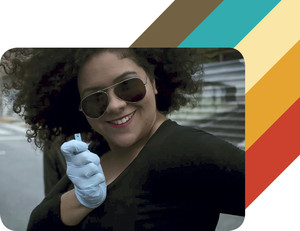 Twenty-eight-year-old Brazilian biologist Natália Cybelle Lima Oliveira was one of the winners of the 2017 “Dance Your PhD” contest promoted by Science Magazine and the American Association for the Advancement of Science (AAAS). This competition challenges researchers to explain the results of their work through dance in the categories Biology, Social Sciences, Physics, and Chemistry. The initiative, which was created ten years ago, attempts to demystify the image of scientists through humor and creativity.
Twenty-eight-year-old Brazilian biologist Natália Cybelle Lima Oliveira was one of the winners of the 2017 “Dance Your PhD” contest promoted by Science Magazine and the American Association for the Advancement of Science (AAAS). This competition challenges researchers to explain the results of their work through dance in the categories Biology, Social Sciences, Physics, and Chemistry. The initiative, which was created ten years ago, attempts to demystify the image of scientists through humor and creativity.
Oliveira completed her doctorate this year at the Federal University of Pernambuco (UFPE). She was the only Brazilian to participate in the contest, which brought together 53 researchers from different parts of the world. With references to the American television program CSI and Voguing, an urban dance style, Oliveira transformed her thesis on biosensors into the video clip Pop, Dip and Spin: The legendary biosensor for forensic sciences.
The biosensor she designed can identify biological remnants such as blood, semen, and saliva on areas cleaned with alcohol, detergents, or bleach, and could be used by forensic investigators at crime scenes. The device relies on a probe—DNA sequences that complement and fit into the molecules investigators are searching for—which is immobilized on the surface of an electrode. When the probe connects to the target sequence, the device produces an electrochemical signal that is recorded and processed by software. The device is in the prototype stage.

With references to the television program CSI and Vogue dancing, this music video explains research on a forensic biosensor
The video was recorded at UFPE. The script and choreography were created by the researcher, who is also an actress and dancer, and by the members of the group Vogue 4 Recife. The audiovisual piece also includes captions summarizing the main points of Oliveira’s research. “The main difficulty was showing the results we obtained, since talking about comparisons between electrochemical peaks generally isn’t an everyday discussion for the general public, but we were able to do this in a playful and practical way, showing what the real-life application of these results would be,” she explains.
Oliveira says that she decided to participate in the contest on the recommendation of a colleague at the Keizo Asami Immunopathology Laboratory (LIKA) at UFPE, where she currently is involved in a post-doctoral internship. “I realized that the convergence between science and art could be an important tool for communication and scientific education,” she adds. “I considered the contest an opportunity to combine academic research with dance and theater, which I’m involved with, and provide visibility for my work.”
Oliveira’s music video won in the Chemistry category by a jury vote. It was also voted the best entry among the finalists, with 78% of the audience vote. According to Oliveira, the US$500 prize (roughly R$1,600) will be shared with the dancers in the video or invested in future productions, such as dance performances or other audiovisual productions in which she is involved. To see the video, visit bit.ly/DYPhd2017.
Republish